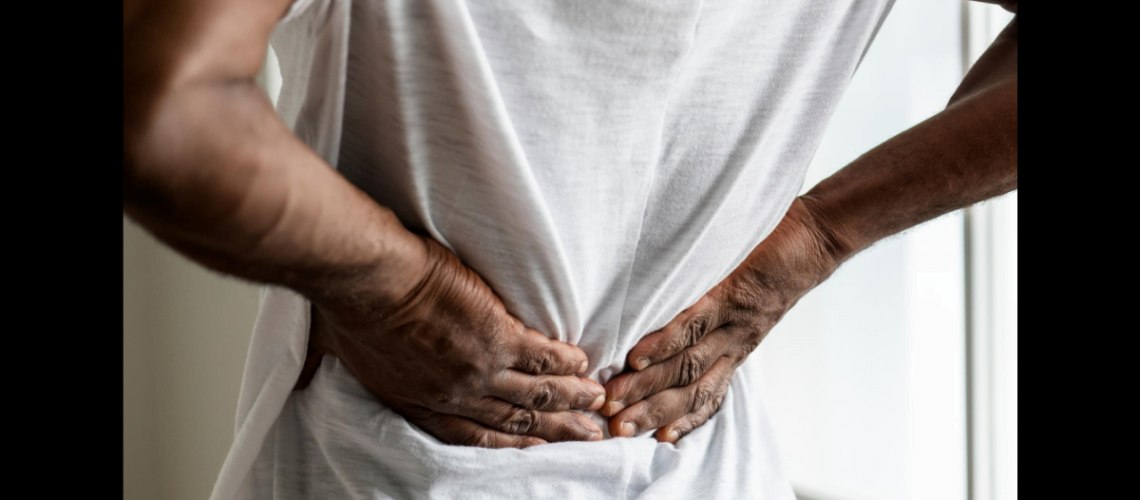Middle back pain, also known as Thoracic back pain, occurs above the bottom of your ribs, between your shoulder blades, and below your neck. The middle back consists of the spinal column, spinal cord, discs, nerves, blood vessels, ligaments, and tendons. Any of these components can be irritated or injured by a variety of causes and conditions.
Middle back pain is not as ubiquitous as lower back pain or neck pain because the thoracic spine does not move as much as the spine in the upper or lower back regions. The pain can be of two variants; a dull, chronic pain and also a sharp, sudden pain that may also restrict movement.
This pain can spread to other parts of the body. But the opposite can also occur, where the pain in other parts of the body can affect your middle back. The pain can also be aggravated by certain sudden movements and postures.
Early detection and prompt treatment of middle back pain can help minimize the effects of the pain and prevent long term repercussions. Mild cases can be treated with home remedies, but more severe occurrences should always be diagnosed by a certified doctor and immediate action must be taken to understand the cause of the pain and work towards relieving it.
A few of the common symptoms for middle back pain are given below.
Middle Back Pain Symptoms
Some of the common symptoms of middle back pain are:
1. Muscle ache
2. Muscle tightness or stiffness
3. Redness, warmth or swelling in parts of the back
4. Fatigue
5. Headache
6. A dull, chronic pain
7. A sudden, sharp or stabbing pain
8. Pain that worsens with certain movements and postures
9. Sleeping problems
10. Chest pain
Now that we’ve listed a few of the common symptoms of middle back pain, let’s try and understand the causes of the pain in the first place.
Middle Back Pain Causes
1. Muscle Sprain or Strain
Sprains are caused when your ligaments are extended beyond their usual range of movement. Strains are caused due to the tearing and stretching of muscles and tendons. Incorrect posture or form while doing certain actions like lifting heavy objects can cause strains or sprains.

Sudden movements or jerks can also lead to straining or spraining of muscles, tendons, and ligaments.
2. Poor Posture
As discussed earlier, poor posture can have a great impact on the back, especially the spine. Pressure on the spine for extended periods of time due to poor posture can lead to middle back pain, The muscles, and ligaments in your back have to work harder to compensate for the poor posture and this strains them, leading to pain.
3. Injury
Though you are less likely to injure your middle back as when compared to your upper or lower back, it is still possible. This is because the middle back is a lot more rigid and does not move very much. Injuries to the middle back usually occur due to a hard fall, blunt force trauma, or a sports injury.
The middle back can be injured by anyone, but older people are at a higher risk.
4. Aging
Pain in the back becomes more likely and commonplace as you grow older. Back pain is typical of people aged between 30 and 60. One of the most common causes of middle back pain in older people include thinning bones due to calcium depletion, reduced muscle mass, and lesser fluid between the spinal joints.
5. Herniated Discs
Discs are cushions present between each vertebra. They act as shock-absorbers and also help you move. When a disc is ruptured and bulges outwards, it is called a herniated disc. This puts pressure on the spinal column and surrounding nerves.
Even a small amount of pressure can result in pain due to the sensitive nature of the region.
6. Obesity
Obesity greatly increases the strain on the muscles, bones, tendons, and ligaments in the back. These components are overworked to compensate for the extra mass. If this continues for a prolonged period of time, it results in pain due to the additional strain.
7. Kidney Ailments
Kidney ailments can cause pain in the middle back due to their location. This pain usually occurs below the ribcage, on either side of the spine. The most common causes of kidney pain are kidney stones and infections. Some of the symptoms of this pain include fever, chills, and nausea.
8. Osteoporosis
Osteoporosis is a bone disease that results in bones becoming very brittle. This occurs when there is a depletion in the calcium density in the bones and the body not being able to produce enough new bone to replace natural bone loss.
People suffering from osteoporosis in the back can develop middle back pain due to stress and depleted range of movement.
9. Vertebral Fractures
Vertebral fractures can occur due to a number of reasons such as trauma, accidents, and injuries. Fractures are also more likely to occur in people with low bone density, such as those suffering from the aforementioned osteoporosis.
Fractures amplify the pain in the middle back, especially if you move. They can also affect the spinal cord and put pressure on it.
10. Mental Health Conditions
Mental health conditions may also play a part in the development of middle back pain. People suffering from conditions such as depression and anxiety stand at a greater risk of developing middle back pain.
As we have discussed the causes of middle back pain in detail, let us now look at some effective home remedies to relieve that pain.
Home Remedies for Middle Back Pain
1. Contrast Therapy
Alternatingly applying heating pads and cold compresses or in more basic terms, ice and heat, to the affected area can greatly help in providing relief from the pain. This is one of the most common methods to treat middle back pain.

2. Posture Improvement
One of the main causes of middle back pain is improper posture. So it makes sense to correct your posture to prevent this from happening in the future and also not aggravate the current pain.
Some basic things to keep in mind to improve your posture are to avoid slouching, taking short walks if you are sitting for long periods of time, and to sit and walk with your spine erect.
3. Workstation Improvement
Sitting in the wrong posture for a long time at your workstation can also lead to middle back pain. Therefore, workstations should be ergonomically organized to ensure that the stress on the back is minimal.
Ergonomic changes such as ensuring that the computer screen is at eye level and that your chair is at the right height can go a long way in preventing middle back pain.
4. Exercise
Exercise may be difficult when you are experiencing middle back pain, but some low impact exercises like a short walk, yoga, or even swimming can be beneficial in alleviating the pain.
Exercise also helps in releasing endorphins, which act as natural pain killers. Exercise can also help prevent middle back pain from developing in the first place.
5. Stretches
A variety of stretches can be performed to relieve yourself from middle back pain. These improve your range of movement and keep the muscles in good shape. Some of the most beneficial stretches are:
Touching your Toes
Touching your toes helps in loosening the muscles of your middle back. It also helps in strengthening the hamstrings, thereby providing greater protection against falls and sudden movements.

Child’s Pose
Kneel down on the ground. Slowly lower yourself onto your heels and sit down. Keep your knees hip-width apart. Slowly, bend forward and place your head on the ground, extending your arms out in front of your head.
Cobra Pose
Lie down flat on your stomach. Gently, lift only the upper half of your body using your arms for support. Your head should be looking up at the ceiling.
6. Sleep
Sleep disturbances can aggravate pain. Proper sleep and rest are crucial for the recovery of muscles, especially those in your back, which have a tireless job throughout the day. Lack of sleep can also affect our level of pain tolerance.
In Conclusion
Middle back pain might not be as commonplace as upper or lower back pain, but it is no less a problem to deal with. It can be extremely painful, bringing your life to a standstill as it does not allow you to move whatsoever without aggravating the pain. Regular exercise, proper posture, and a good amount of rest can help prevent the pain from developing. Older people must take special care to keep this pain at bay. As always, prevention is better than curing and home remedies can be used effectively to alleviate pain. But keep in mind to consult a certified doctor if the problem persists and take immediate action to prevent the pain from developing into a serious, long term issue.








